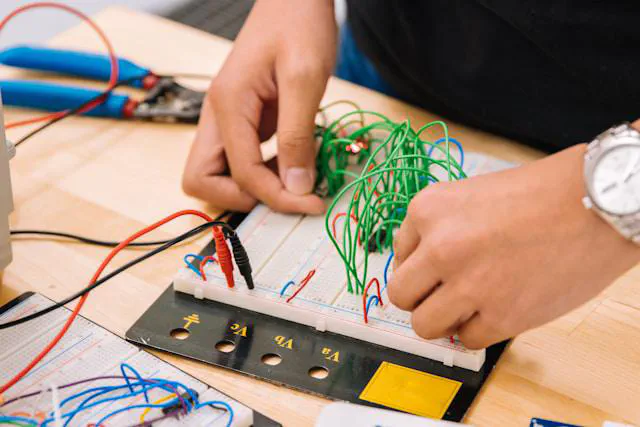With almost 30 billion connected devices, this isn’t Al Gore’s internet anymore. Consider this: According to Cisco’s Annual Internet Report, there will be 29.3 billion internet-connected devices in 2023, or more than three for every human. The internet has no doubt transformed society and industry, while proving to be resilient and scalable. It also continues to evolve.
Under the hood, we believe there are five technologies that are transforming the web. Many of these technologies have been around for years, but are now gaining widespread adoption and becoming the foundation for new applications, experiences, and systems.
#1: Artificial Intelligence/Machine Learning (AI/ML)
Let’s start with the most obvious and least “quiet”: AI/ ML. We’ve all experienced the hype (and most likely the disappointment). What might not be obvious is that the most impactful applications of AI/ML are the ones you never hear about.
Companies have begun to natively weave AI/ML into a range of consumer and business applications, applying it to specific use cases. One timely example on the consumer side are health applications and devices that can track a variety of vitals specific to a user, some of which raise ethical and privacy issues. Fraud detection and cost optimization are good examples of use in industry. AI/ML depend both on models and, most crucially, the quality and volume of data. Increasingly, what matters more is the application of data in context.
From an ethical perspective, this raises questions about privacy and data custodianship, especially with consumer apps: who owns the data and thus can derive the most value from it? When is data being packaged and sold to third parties? How do users opt in and opt out? How are the underlying models managed and audited?
We’ve seen a range of data privacy laws emerge over the past few years. Moreover, data across applications tends to be siloed, providing only a partial picture or incomplete solution. This poses a challenge for differential privacy as well as to data engineers charged with integrating data models to deliver user-facing features with better insights and richer experiences.
#2: HTTP2 & HTTP3
One of the core protocols underlying the internet is Hypertext Transfer Protocol, also known as HTTP. At its core, HTTP is an application-layer protocol that enables websites and servers to communicate and share resources. When a user lands on a website, an HTTP request is sent to a remote web server, which then receives, processes, and responds to the request with an HTTP response.
HTTP/1.1 has proved a durable and elegant solution to share media resources across the web. However, its plaintext encoding has meant it has had to adapt to fit many use cases it wasn’t designed for, such as web sockets and long-term connections. As an analogy, HTTP/1.1 is like the Model T automobile, in that Henry Ford didn’t know we would build interstate highways; HTTP/1.1 simply wasn’t designed to handle massive-scale internet traffic and multi-modal content.
HTTP/2 marks a significant evolution from HTTP/1.1. Standardized in 2015, the primary difference is that HTTP/2 is a binary format in contrast to the plaintext encoding of HTTP/1.1. Because of its binary encoding, HTTP/2 allows for full duplex communication, handling multiple requests in parallel over one connection. Moreover, HTTP/2 adds security and massively improves performance, such as variable inline encoding, compression, and better performance management overall. In other words, HTTP/2 is much better suited than its predecessor for secure, multi-channel communication at scale.
Currently, HTTP/3 is under development as a standard and gaining traction. HTTP/3 better addresses how we access the internet today — with users streaming data across multiple devices, locations, and access points. The bottom line: mass adoption of HTTP/2 and HTTP/3 will enable a diversity of richer and more secure experiences across modalities.
#3: Event-driven Architecture (EDA)
Since Apache Kafka was open sourced in 2011, event-driven applications have gained popularity. Event-driven Architecture (EDA) refers to a design pattern for building applications as a collection of highly decoupled, single-purpose event processing components that asynchronously receive and process events.
This design pattern allows organizations to track and detect “events” and then instantly act on them. Events are broadly defined as “a significant change in state.” Depending on the context, this could be anything from a consumer placing an item in an online shopping cart to a sensor reading a threshold temperature.
EDA is perhaps best understood in contrast to conventional application frameworks. Traditional web applications follow a request-response design pattern: a resource such as a server or database waits for a client to make a request. Once a request is made, the server responds and waits for the next request. In effect, communication is passive, which affects performance, user experience, and potentially availability, since both client and server depend on a synchronized connection.
EDA flips this approach by employing active agents or components that produce and consume events asynchronously. Producers publish events to a log (or logs) that any number of Consumers can subscribe or listen to and act upon. With EDA, data flows move from a passive, “polling/querying” approach to an active, “subscribe to a stream of changes” approach.
Traditional data ingestion models require some a priori plan for how the data will be queried once it has been collected, and data modeling decisions are very difficult to modify once they’ve been implemented. That often means a lot of compromises have to be made for potential downstream applications that are all using the same underlying database. By contrast, EDA opens up the possibility for each unique downstream application to consume and transform data in its most raw form.
EDA-designed applications consist of active agents/components passing messages to each other, more effectively mirroring real-life data flows and communications, instead of passive services. EDA opens the door to interactions and streaming experiences that are more immediate and high-quality, and that possess a greater capacity for resiliency and fault tolerance due to its asynchronous design.
From an analytics perspective, EDA allows for more granular, higher-frequency updates on a continual basis, leading to much fresher data and quicker time to insight as opposed to “batch” paradigms defined as one big update, once per day, and slow to query.
#4: WebAssembly (WASM)
On the front-end side of web applications (i.e. what users typically interact with in the browser), WebAssembly(WASM) is gaining traction. Released in 1995 by Netscape, Javascript and its many offspring web frameworks have been the primary languages for developing interactive front-end or client-side web interfaces.
While Javascript still dominates today, it was not natively designed for CPU-intensive applications such as video processing, 3D rendering, multimedia games, cryptographic computations, and augmented/virtual reality (AR/VR) applications in the browser. WASM fills this (rather large) gap as user expectations change and backend systems evolve to support more broad, computationally-intensive applications. Developed by the World Wide Web Consortium (W3C) and released in 2015 as a standard, WASM 1.0 is supported by Chrome, Firefox, Safari, and Edge to handle high-performance applications.
To be clear, WASM is not a new programming language so much as it is a new approach to writing browser-understandable machine code. The fundamental idea is that the browser has a virtual machine that executes machine code with its own instruction set. Developers can write programs in any programming language — such as Javascript on the client side or C on the server side — and these programs are then compiled by a WASM module into machine code.
WASM was designed to be fast, efficient, portable, and secure. Because WASM compiles machine code in the browser, the browser handles its access to operating system features so it can leverage common hardware capabilities to execute at near native speeds. Portability is also important. Since WASM provides a conceptual machine with a binary instruction format, it executes independently of operating systems, browsers, and languages while maintaining backward compatibility.
Together with the WebAssembly System Interface (WASI), WASM offers an alluring future: developers will be able to build high-speed web apps in the language of their choice with a fast, scalable, secure way to run the same code across all devices i.e. in the browser, locally, in the cloud, and at the edge.
#5: Distributed Systems
As more users, devices, and geographies connect online, complexity increases and backend distributed systems become more important. Distributed systems go beyond cloud computing: distributed systems invoke independent components installed on different systems (cloud or not) to communicate with one another across geographies to achieve a shared objective.
Application developers have to manage an array of increasing complexities, both technical and social. On the technical side, there are issues of security, consistency, consensus, performance, maintainability, and durability across an increasingly mobile and diverse user base. From a social perspective, there are issues of consumer privacy and compliance with data sovereignty laws (as noted in #1 above) as well as increasing interest in data transparency and custodianship.
Backend distributed systems will play a key role in designing, managing, and maintaining next generation applications that meet user expectations for performance, security, privacy, and availability. At Rotational, we believe many of these issues revolve around locality: putting the computing resources where they need to go, no matter where that is. Computing and storage in context have become increasingly important, and distributed systems are a critical element to making complexity possible and manageable.
An Internet Where Every Device Is A Data Center
We live in an age when every device is a data center. The internet and its underlying technologies are evolving to adapt to this reality. Application developers and organizations that build digital products must also adapt and leverage these technologies to build more engaging, performant, secure, and privacy-first applications. Moreover, these technologies should not just be in reach of large, well-resourced cloud-native tech companies; they should be accessible to all builders.
At Rotational, we think deeply about these issues and how to support developers building next-generation applications. Over the next few months, we’ll take a deeper dive into each of these technologies or trends. We hope you (and Al Gore!)1 come along for the ride.
Photo by Rajiv Bajaj on Unsplash
According to Robert Kahn and Vinton Cerf, Al Gore does deserve credit for his early support of the internet. ↩︎










